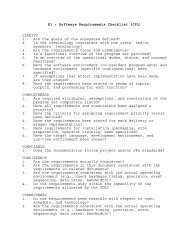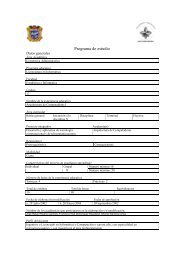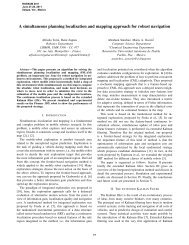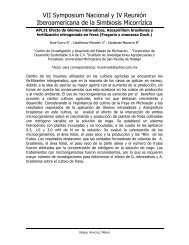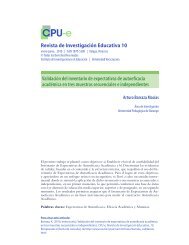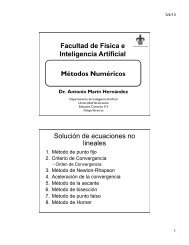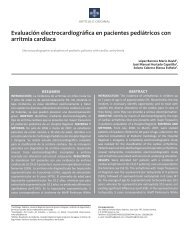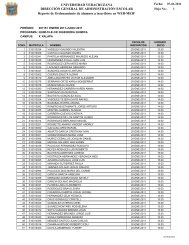Understanding the Software Options
Understanding the Software Options
Understanding the Software Options
Create successful ePaper yourself
Turn your PDF publications into a flip-book with our unique Google optimized e-Paper software.
Lozowski<br />
FIGURE 2. The �at-plate reactor contains a<br />
series of parallel �at plates<br />
channels that use paddlewheels for<br />
mixing. These are <strong>the</strong> most common<br />
algae cultivation systems in use today.<br />
A main advantage is that <strong>the</strong>y are<br />
inexpensive to build. Disadvantages<br />
include evaporation of water, and<br />
difficulties in keeping out unwanted<br />
species and controlling <strong>the</strong> process.<br />
The open structure of <strong>the</strong>se systems<br />
makes <strong>the</strong>m susceptible to infections<br />
and limits <strong>the</strong> choice of algae to fastgrowing,<br />
resistant strains. Ano<strong>the</strong>r<br />
disadvantage is <strong>the</strong> large footprint<br />
needed for scaleup.<br />
Horizontal tube reactors (Figure<br />
1) are single layers of clear horizontal<br />
tubes through which <strong>the</strong> algae are<br />
circulated. Advantages are that <strong>the</strong><br />
productivity per surface area is higher<br />
than in an open pond, process control<br />
is better because it is in a closed loop,<br />
and scaleup can be fairly straightforward<br />
by extending <strong>the</strong> length of<br />
<strong>the</strong> tubes. A main disadvantage with<br />
horizontal tubes is <strong>the</strong> high intensity<br />
of light on <strong>the</strong> tube surface, which can<br />
be detrimental to algae growth. Additional<br />
disadvantages are <strong>the</strong> cost of<br />
circulating <strong>the</strong> fluid in <strong>the</strong> tubes and<br />
<strong>the</strong> O 2 buildup in <strong>the</strong> closed loop that<br />
can slow algae growth.<br />
Vertical tube reactors are basically<br />
vertical rows of horizontal tubes.<br />
This configuration greatly decreases<br />
<strong>the</strong> very high-intensity light associated<br />
with horizontal tubes, and decreases<br />
<strong>the</strong> footprint needed with<br />
horizontal tubes.<br />
Flat-plate reactors (Figure 2) consist<br />
of a series of flat, parallel plates<br />
in a closed reactor system. These large<br />
polymeric “bags” are filled with water<br />
and form a big heat sink so that temperature<br />
control is an advantage in<br />
this system. The flat-plate reactors<br />
also afford some of <strong>the</strong> same advantages<br />
of <strong>the</strong> o<strong>the</strong>r closed systems,<br />
namely better process control and purity.<br />
Good mass transfer is obtained<br />
TABLE 1. ADVANTAGES AND DISADVANTAGES<br />
OF THE FOUR ALGAE REACTOR TYPES<br />
Raceway Horizontal Vertical Flat-plate<br />
Ponds Tubes Tubes reactors<br />
Inexpensive to build yes unknown unknown unknown<br />
Easy to scale up yes yes yes no<br />
Good process control no yes yes yes<br />
Maintain purity no yes yes yes<br />
Optimum light intensity yes no yes yes<br />
Low footprint<br />
Maintain water level (no<br />
no no yes yes<br />
evaporative losses)<br />
Low-cost to circulate<br />
no yes yes yes<br />
fluids<br />
Maintain good gas bal-<br />
yes no no no<br />
ance (no O2 buildup) yes no no yes<br />
by sparging air in <strong>the</strong> panels, so O 2<br />
buildup is not a problem. Scaleup of<br />
this system is, however, complex.<br />
The tube diameter of <strong>the</strong> systems in<br />
AlgaePARC is 5.5 cm — “large enough<br />
to prevent blockages and small enough<br />
for good heat transfer”, Wijffels explains.<br />
Density measurements are used<br />
to detect when <strong>the</strong> algae are ready for<br />
harvesting, which is typically done by<br />
circulating <strong>the</strong> biomass to a centrifuge.<br />
While fouling can be a factor in all<br />
of <strong>the</strong>se systems, Wijffels says that it<br />
depends on <strong>the</strong> type of algae used and<br />
how <strong>the</strong> algae are treated. Stresses,<br />
such as large temperature swings<br />
can cause a sticky substance to be secreted.<br />
Beads, however, can be used in<br />
circulation loops to help clear fouling.<br />
Within a couple of years, <strong>the</strong> AlgaePARC<br />
team hopes to have learned<br />
enough from <strong>the</strong>se four reactors to<br />
build a fifth, optimized system.<br />
Lactic acid and PLA<br />
Polylactic acid (PLA) is a bio-based<br />
plastic that is a sustainable alternative<br />
to oil-based polymers, and <strong>the</strong> demand<br />
for PLA’s monomers, lactic acid<br />
and lactides, is rising (see Bio-Based<br />
Chemicals Positioned to Grow, Chem.<br />
Eng., March 2011, pp. 19–23). Rop Zoetmeyer,<br />
CTO of Purac (Gorinchem,<br />
<strong>the</strong> Ne<strong>the</strong>rlands; www.purac.com),<br />
says that <strong>the</strong> market for PLA is estimated<br />
to reach over three million tons<br />
in <strong>the</strong> next ten years. Purac, a subsidiary<br />
of CSM N.V. (Diemen, <strong>the</strong> Ne<strong>the</strong>rlands;<br />
www.csm.nl) is a market leader<br />
in lactic acid production.<br />
Zoetmeyer says that Purac’s technologies<br />
comply with <strong>the</strong> cradle-to-cradle<br />
concept, and that sustainability is key<br />
for bio-based chemicals. Purac is currently<br />
working on two projects toward<br />
lowering its eco-footprint — which<br />
Zoetmeyer explains means more than<br />
just a favorable CO 2 footprint — for<br />
lactic acid production: a gypsum-free<br />
lactic acid process; and a process using<br />
alternative, non-food raw materials.<br />
A gypsum-free process. In <strong>the</strong> current<br />
process, carbohydrates are fermented<br />
to produce lactic acid. Lime<br />
is added for pH control, and <strong>the</strong>n sulfuric<br />
acid is added to convert calcium<br />
lactate into lactic acid and gypsum<br />
(CaSO 4) as a byproduct. A separation<br />
step removes <strong>the</strong> gypsum and biomass<br />
and a subsequent purification<br />
separates out <strong>the</strong> lactic acid residue<br />
and yields <strong>the</strong> purified lactic acid. In<br />
<strong>the</strong> new process, nei<strong>the</strong>r lime nor sulfuric<br />
acid are used, eliminating <strong>the</strong><br />
formation of gypsum and <strong>the</strong> associated<br />
steps to remove it. The result is a<br />
much simplified process.<br />
This patented, gypsum-free process<br />
has been run on a demonstration<br />
scale for two years, and scale up to a<br />
production-scale plant is planned. The<br />
site of <strong>the</strong> new plant is expected to be<br />
chosen by <strong>the</strong> end of 2011.<br />
Non-food substrates. In order to<br />
move away from competing with potential<br />
food sources for carbohydrates<br />
and sugar, Purac is working on using<br />
non-food substrates, such as corn stover<br />
or bagasse. The company’s goal is<br />
to have a commercial plant for producing<br />
PLA monomers using non-food<br />
substrates in 2015. The location of<br />
<strong>the</strong> plant will, in part, depend on <strong>the</strong><br />
availability of <strong>the</strong> substrate chosen.<br />
New bioplastics<br />
Avantium (Amsterdam, <strong>the</strong> Ne<strong>the</strong>rlands;<br />
www.avantium.com) has developed<br />
a patented process to produce<br />
furanic building blocks, tradenamed<br />
YXY, that can be used for new, biobased<br />
plastics. Using high-throughput<br />
experimentation technology, <strong>the</strong> company<br />
has identified catalysts that can<br />
convert carbohydrates into furanic<br />
molecules in a very selective and fast<br />
way, it says. Since <strong>the</strong> process is a catalytic<br />
one, it can utilize existing CPI<br />
CHEMICAL ENGINEERING WWW.CHE.COM AUGUST 2011 15



